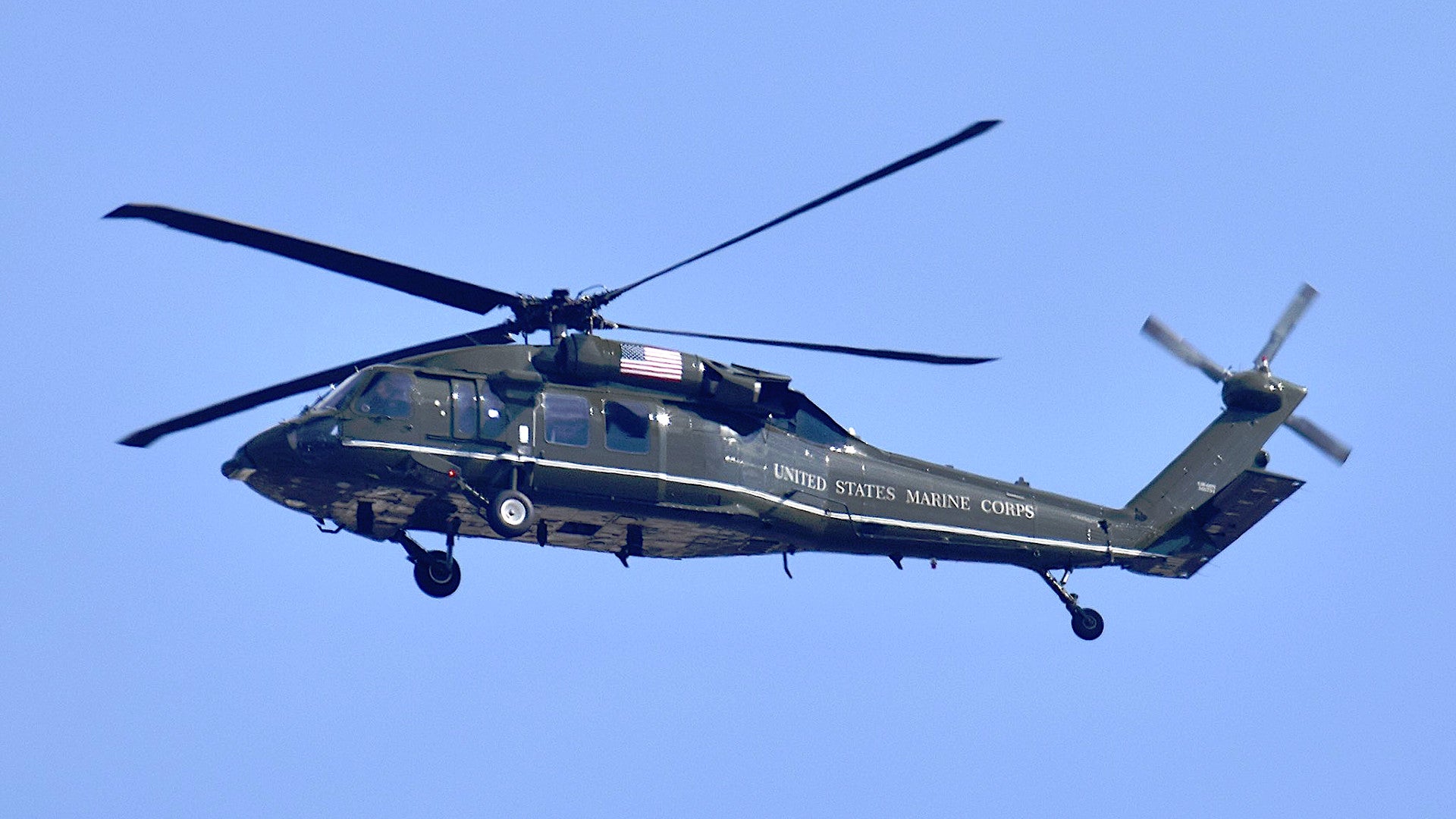A rare picture has emerged of what is almost certainly the lone UH-60N helicopter assigned to Marine Helicopter Squadron One’s “green top” fleet, which also includes a dozen MV-22 Osprey tiltrotors. This unit, abbreviated HMX-1, is better known for its “white top” fleet that provides the “Marine One” VH-3D and VH-60N helicopters that move the president, their family, and their closest advisors around at home and abroad. HMX-1 is in the early stages of replacing those helicopters with new VH-92As, which you can read more about in these past War Zone pieces.
Twitter user @holy_itsViper grabbed a picture of this helicopter flying over Washington, D.C., on Feb. 9, 2021, and was kind enough to share it with us. HMX-1’s main base of operations is at Marine Corps Air Facility Quantico in Virginia, but it also has a detachment at Joint Base Anacostia-Bolling in the nation’s capital. The squadron’s helicopters also routinely fly to and from the White House, the Pentagon, and the U.S. Naval Observatory, the latter location being where the Vice President’s residence is situated.

This helicopter appears to have arrived at HMX-1 sometime between 2015 and 2016, based on annual Marine Aviation Plan reports. It was also confirmed to still be part of the squadron in a report on noise from helicopters operating in the greater Washington area that the Government Accountability Office (GAO), a congressional watchdog, published in January of this year. None of these reports have included any pictures of the UH-60N or provided detailed descriptions of what its exact roles and missions might be, but The War Zone has already reached out to the Marine Corps for more information.
If this helicopter is the UH-60N, it appears to have only the most general relationship to the heavily-modified VH-60N “Marine One” helicopters, which have robust communications suites, extensive countermeasures, and other systems necessary to meet the needs of the President and other VVIPs. Externally, the green top helicopter appears to share much more with the MH-60S Seahawk, and it may even be a derivative thereof.
The MH-60S, originally designated the CH-60S and also known colloquially as the Knighthawk, is a hybrid of sorts between the U.S. Army’s UH-60L Black Hawk and earlier U.S. Navy Seahawk variants. MH-60S helicopters can be readily identified by a distinct protrusion under the nose, where a turret containing electro-optical and infrared video cameras can be mounted, something also seen on this apparent UH-60N.


While we don’t know how HMX-1 utilizes its UH-60N, we do know that the squadron’s green top fleet, as a whole, primarily provides a lower-tier of support for presidential missions by moving around White House staff, members of the media, specialized quick reaction teams, Secret Service personnel, and other official guests. It’s worth noting that the MV-22s that now make up the bulk of the green top fleet had replaced the CH-46 Sea Knight helicopters that the squadron had previously operated. Those tiltrotors also helped fill the gap left by the earlier retirement of the squadron’s CH-53D/E Sea Stallions. The MH-60Ss supplanted H-46 variants when they entered service with the Navy, as well.


So, it’s certainly possible that the UH-60N, which looks, as its designation implies, to be configured for general utility missions, could provide useful additional capacity for HMX-1’s green side. This helicopter would have the benefit of being able to operate from landing spaces too small to safely accommodate the much larger MV-22s and the powerful downwash from their rotors. Flying tree branches and other debris kicked up by an MV-22 injured 10 people during a demonstration on Memorial Day in 2010 in Clove Lakes Park on Staten Island in New York City.


However, the UH-60N’s main job appears to be as a training platform for crews destined to fly HMX-1’s white top VH-60Ns. Marine Aviation Plans initially referred to it as a “TH-60N.”
HMX-1 faces a significant and unique training bottleneck due to the fact that the white side of the unit is so security-sensitive that its helicopters are literally caged off from the others. It can take up to a year for aviators and other personnel to get the necessary security clearances to work in those spaces, let alone fly those aircraft. Having a similar, but largely unclassified airframe offers pilots and ground crews a way to get started on any necessary training while the clearance process is still ongoing.
HMX-1 also acquired a Sea King helicopter, initially referred to as a TH-3D and then later described as a UH-3D, around the same time as it got the UH-60N, for the same general reasons. This UH-3D should not be confused with the NVH-3A Marine One test helicopter that Air Test and Evaluation Squadron 21 (HX-21) finally retired last year, which also wore a green top paint scheme.

HMX-1 is already in the process of acquiring a small fleet of CH-92As that will primarily provide similar training support for its new VH-92As.
Of course, none of this is to say that the UH-60N couldn’t still be employed in non-training roles, if necessary. The “U” designation rather than “T” one would suggest the squadron views it as a more general-purpose airframe.
However HMX-1 employs this helicopter, it already appears to be in the twilight of its relatively short service with the squadron. As of 2019, the plan was to divest it in the middle of 2022 as part of the transition on the white side from the VH-3Ds and VH-60Ns to the VH-92As.

No matter what, it’s very interesting to see this extremely camera shy member of one of the Marine Corps’ most well-known aviation units.
Contact the author: joe@thedrive.com
